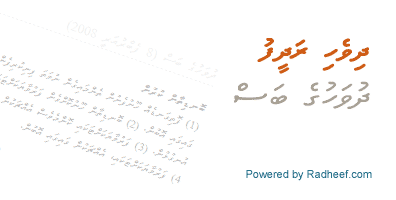Thursday, May 8. 2008
Thaana conversions class for PHP 5 - v0.2
Here is an update to the Thaana conversions class I released in Nov 2007. This new version 0.2 release expands the varieties of conversions available and should be more than adequate for almost all uses. This version, most importantly, adds solid UTF-8 conversion functions allowing for more flexibility in PHP-based Unicode/UTF-8 Thaana handling. Further, the class is now licensed under the pretty liberal Open Source MIT License. The code still relies solely on core PHP 5 functions and does not demand any extra PHP extensions to be installed.
Convert UTF-8 data to Unicode character integer representations
- convertUtf8ToAscii()
Convert UTF-8 data to Ascii
- convertEntitiesToUnicodeIntegers()
Convert HTML Unicode entitied string to Unicode Integer characters array
- convertEntitiesToUtf8
Convert HTML Unicode entities to UTF-8
- convertEntitiesToAscii()
Convert HTML Unicode entities to Dhivehi Ascii equivalents
- convertUnicodeIntegersToUtf8()
Convert Unicode Integer array to UTF
- convertUnicodeIntegersToEntities()
Convert Unicode char integers to HTML entities
- convertUnicodeIntegersToAscii()
Convert Unicode char integers to Ascii
- convertAsciiToUtf8()
Convert Ascii Thaana to UTf-8
- convertAsciiToUnicodeEntities()
Convert Ascii Thaana to Unicode HTML entities
- convertAsciiToUnicodeIntegers()
Convert Ascii Thaana to an array of Unicode integers
Drop me a line if you run into trouble with any of the functionality or have comments/queries. Enjoy
Update (11-Sep-2008): This version is now superseded by the v0.3 release.
Functions exposed by the class
- convertUtf8ToUnicodeIntegers()Convert UTF-8 data to Unicode character integer representations
- convertUtf8ToAscii()
Convert UTF-8 data to Ascii
- convertEntitiesToUnicodeIntegers()
Convert HTML Unicode entitied string to Unicode Integer characters array
- convertEntitiesToUtf8
Convert HTML Unicode entities to UTF-8
- convertEntitiesToAscii()
Convert HTML Unicode entities to Dhivehi Ascii equivalents
- convertUnicodeIntegersToUtf8()
Convert Unicode Integer array to UTF
- convertUnicodeIntegersToEntities()
Convert Unicode char integers to HTML entities
- convertUnicodeIntegersToAscii()
Convert Unicode char integers to Ascii
- convertAsciiToUtf8()
Convert Ascii Thaana to UTf-8
- convertAsciiToUnicodeEntities()
Convert Ascii Thaana to Unicode HTML entities
- convertAsciiToUnicodeIntegers()
Convert Ascii Thaana to an array of Unicode integers
Usage
<?php
// Load class and initialize object
require 'thaana_conversions.obj.php';
$thaana = new Thaana_Conversions();
echo $thaana->convertEntitiesToAscii('ދިވެހި');
echo $thaana->convertAsciiToUtf8('rWacje');
?>
Download:
- Thaana_Conversions.zip (v0.2, 3KB)Drop me a line if you run into trouble with any of the functionality or have comments/queries. Enjoy
Update (11-Sep-2008): This version is now superseded by the v0.3 release.




